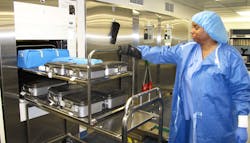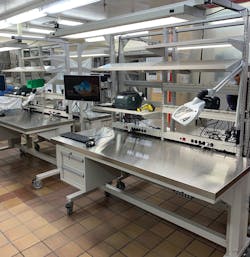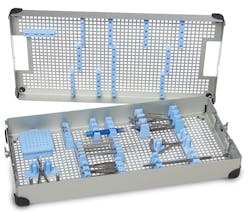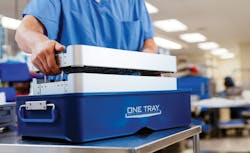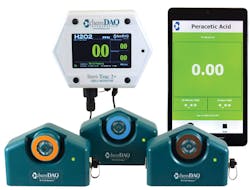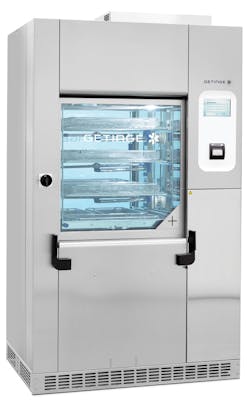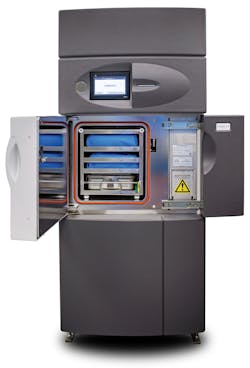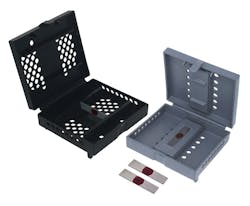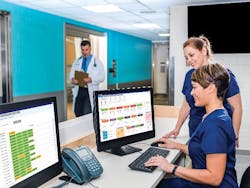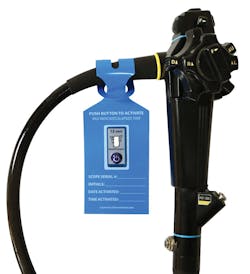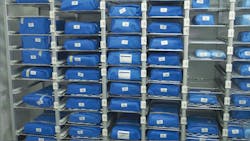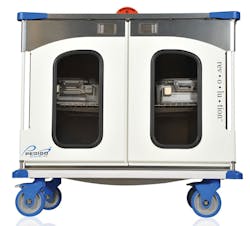2019 SPD Resource Guide: Want SPD to succeed? Ask what they need!
Sterile processing professionals have been fighting for what they need to do their jobs well for a long time, and it’s been a tough battle for many. That’s because historically, the SPD/CS often wasn’t viewed as a top priority, not until lately, and even now experts say there’s more to be done. Nonetheless, a variety of recent circumstances — some good, some bad — is beginning to shift sterile processing into proper focus in the eyes of an increasing number of healthcare decision-makers.
An onslaught of media reports of patients developing infections, some fatal, from dirty instruments is likely the biggest factor. We’ve also been exposed to news of repeated violations for inadequate staff and training, lack of equipment and other resources.
Those are some of the unfortunate events that have forced providers to act, but encouraging developments are also attracting attention and affecting positive change in the SPD.
Advocacy groups such as IAHCSMM, CBSPD, AAMI, as well as universities, sterile processing consultants, and suppliers have joined the effort to educate people about the critical role sterile processing departments play in the overall health of an organization. We also see more individuals working on the frontlines in SPD making a strong presence on social media channels, in podcasts, publications, electronic newsletters and other forms of communication. There’s still more to be done to make SPDs nationwide more visible in the public eye, adequately staffed and armed with the materials, education and support they require to excel, but sterile processing has come a long way.
“Without a doubt, one of the most important changes in our industry are the increasing options available to our teams to proactively monitor chemical exposure of our frontline personnel in the department,” Balch said. “With the historical lack of visibility and undervaluing of our profession, also came a dangerous acceptance of chemical exposure and risk as ‘just part of the job’ of a sterile processing technician. But with so many different chemicals in use, in so many different areas of the workflow, our people were constantly placed in scenarios where exposure danger could be substantial, and we would have no way of knowing until days, weeks, or even years later — and all of this being far too late. The industry is finally waking up to realize these dangers are no longer acceptable, and technology is rolling into the market with the primary goal of protecting our most precious assets, our people.
“Besides chemical monitoring, our industry is being completely revolutionized with the power of big data,” Balch continued. “With more and more SPD departments coming on-line with these high-powered data platforms, tracking systems, and vendor management software, leaders are able to drive improvements and efficiencies which would have been impossible in previous generations of healthcare management. Data is finally able to tell us what is truly going on in our workflows, and just as importantly, what is going on in similar departments across the street and across the globe. This ability to compare processing data is a true game-changer now and in the years to come.”
Supplier support … or not?
Suppliers of sterile processing equipment and services want to sell their stuff first and foremost, that’s a given, and rightfully so. But how closely do they listen to what their customers need and want? Balch says they could be more mindful of what sterile processing professionals are truly up against and that some of the stress SPDs encounter may be the result of the vendors themselves.
“There are a great many vendors in this industry who truly care for the people of SPD and the patient at the end of all our processes,” he said. “But the truth of the matter is that caring alone is not enough. Unfortunately, large numbers of vendors and their representatives currently serving this space lack the basic competencies necessary to understand how their product or service actually can and should fit into a proper sterile processing workflow.
“Too many vendor in-services are being given that do not even reflect the manufacturers own instructions for use, and too much advice is being poured into departments with little regard to industry recommendations and established best-practice,” Balch continued. “While no one would argue these vendors are missing the mark on purpose, they are missing it nonetheless, and leaving in their wake growing numbers of confused, misinformed, and jaded SPD professionals. Vendors owe it to their hospital customers to gain a real, thorough understanding of the what, why, and how of surgical instrument reprocessing, before impacting them with their products or service.”
Vendor views
From a vendor perspective, Healthcare Purchasing News wanted to know what vendors think SPD’s pain points are — generally and specifically — as they relate to various industry segments.
Workstations
“From our experience the space planning and work flow requirements for new construction or renovation projects for Sterile Processing Departments is always an afterthought,” said Ian Loper, DSI Direct. “Space limitations within a CS/SPD is the number one issue our customers experience. With an increase in procedures within the OR there will be an increase in instrumentation with rigid containers, blue wraps, and peel packs that need to be managed and stored efficiently and most CS/SPDs are busting at the seams within the four walls they need to operate in. From a planning perspective, this is a fundamental issue as each department is fighting for more space to effectively function without disruption.”
“We have noticed greater Infection Preventionist involvement with SPD in regard to trays, containers, and transport containers,” said Aaron Lieberman, Marketing Manager at Summit Medical, an Innovia Medical Company. “IPs are looking for products that are designed, tested, and validated for the specific parameters of everyday product use. In the past year, IPs have increasingly sought us out to talk about validated solutions. Whether we’re talking trays or transport containers SPD is always involved. Validations were the hot topic at our booth at APIC last year and the IPs always said, ‘I’ll get with my SDP person and reach out to you.’ In my opinion, the days of using off-label products without validations are numbered. IPs are looking for products that improve the instrument reprocessing effectiveness and ultimately the patient’s outcome.”
Managing loaners
“Loaner set management is a trying process,” said Jill Loring, Clinical Program Director, Censis Technologies. “Most hospitals don’t have visibility to the number of loaner trays expected each day; they also aren’t aware that trays are being delivered late — until it’s too late. Combine late delivery with an unexpected quantity of trays, and you have a recipe for disaster. In fact, 84 percent of hospitals’ first cases are delayed, many of which are due to loaner trays not being ready for use. Consider the average cost per OR minute is $80, and hospitals are losing millions on their bottom line.”
Leaky sterilizers
“Studies have shown that HP sterilizers can and do leak,” said Pamela Konstantakis, Marketing Manager, ChemDAQ.“ Many people view HPG as much safer than EtO primarily because the former is more familiar. However, the OSHA Permissible Exposure Limit (PEL) is the same in both cases and HPG is considered a known animal carcinogen according to the American College of Governmental Industrial Hygienists (ACGIH). In addition, because of shorter cycle times, sterile processing technicians are unloading items from the HPG sterilizers much more often. This greatly increases potential exposure due to residual HPG vapor upon opening the sterilizers.”
Using & testing washer disinfectors
“In many strategic respects, the SPD serves as the hospital’s traffic control center where the timely throughput of essential instruments and equipment helps ensure uninterrupted surgical workflows that impact operational efficiency, patient outcomes and financial performance in the OR, which accounts for as much of 65 percent of an institution’s revenue,” said David Rizzo, Marketing Manager, Getinge. “Unfortunately, increasing workloads have not been matched by a commensurate addition of staff or equipment resources to keep pace with rising processing volume. Consequently, human and technological assets have become taxed to the limit. Space limitations and the lack of funding to reconfigure or expand the SPD’s footprint only exacerbate the problem. In a number of institutions, employee safety concerns and staff turnover have become a natural by-product of a chronically stressed workplace.”
Probe reprocessing
“A major concern is preventing multi-drug resistant organism (MDRO) transmission. Antibiotic resistance is one of the biggest public health challenges of our time with the CDC reporting that 2 million people get an antibiotic-resistant infection each year, and at least 23,000 people die,” said Crystal Treat, Clinical Applications Specialist, Nanosonics. “It is more important than ever to ensure procedures in hospitals are classified correctly — critical, semi-critical, or non-critical — to to determine how ultrasound probe equipment should be disinfected.”
Endoscopes
“Cleaning and reprocessing endoscopes is an intensive process with multiple steps and procedures that require the utmost in attention and focus by reprocessing technicians,” said Olympus. “Delayed cleaning and reprocessing creates more work later, as the scopes may develop biofilm and become harder to clean. When scopes are cleaned outside of the 60-minute threshold, facilities must follow “delayed reprocessing procedures” that include more steps and safety measures -- something facilities want to avoid. Today most facilities do not have a meaningful way to get control of this metric.”When case turnover and set size increases and the space SPD works in is shrinking, space utilization is serious business. Phillip Van Gorp, Sales Director, Belintra, Inc. “Most modular storage and transport investments are based on current set counts rather than projected set storage requirements, which are likely to expand.
“Poorly designed and inefficient storage systems often feature standard wire racking with sharp edges or metal runners, which increase the potential risk for tears, cuts and holes in wrapped instrument sets,” Van Gorp continuted. “Stacking wrapped sets directly on top of each other may seem like an effective way to save on space. In reality, it’s an inefficient system that can lead to damaged or wet packs and could increase the time required to track instrument sets.”
“A storage system using these racks can be a maze to navigate and finding a certain item can be like finding the proverbial needle in a haystack,” said David M. Phillips, Marketing Manager, Hänel Storage Systems. “Because items can become so buried, it’s not uncommon for supplies with limited shelf lives to take up space long past their expiration dates. The amount of bending and extending done by SPD staff is an issue as well … It doesn’t take much to strain a wrist or pull a back muscle. In addition, the open tops of all types of racks expose stored items to dust and drips from HVAC units, and their overall openness means that sterile items are prone to being handled far more times than they should be.”
About the Author

Valerie J. Dimond
Managing Editor
Valerie J. Dimond was previously Managing Editor of Healthcare Purchasing News.
